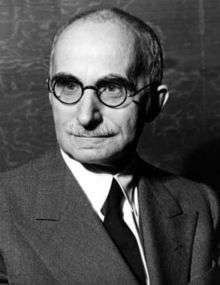Luigi Einaudi
| His Excellency Luigi Einaudi OMRI | |
|---|---|
 | |
| 2nd President of Italy | |
|
In office 12 May 1948 – 11 May 1955 | |
| Prime Minister |
Alcide De Gasperi Giuseppe Pella Amintore Fanfani Mario Scelba |
| Preceded by | Enrico De Nicola |
| Succeeded by | Giovanni Gronchi |
| Deputy Prime Minister of Italy | |
|
In office 1 June 1947 – 24 May 1948 | |
| Prime Minister | Alcide De Gasperi |
| Preceded by | Position established |
| Succeeded by | Giovanni Porzio |
| Minister of the Budget | |
|
In office 6 June 1947 – 24 May 1948 | |
| Prime Minister | Alcide De Gasperi |
| Preceded by | Position established |
| Succeeded by | Giuseppe Pella |
| Governor of the Bank of Italy | |
|
In office 5 January 1945 – 11 May 1948 | |
| Preceded by | Vincenzo Azzolini |
| Succeeded by | Donato Menichella |
| Personal details | |
| Born |
24 March 1874 Carrù, Piedmont, Kingdom of Italy |
| Died |
30 October 1961 (aged 87) Rome, Latium, Italy |
| Nationality | Italian |
| Political party | Italian Liberal Party |
| Spouse(s) | Ida Pellegrini |
| Children | Giulio |
| Alma mater | University of Turin |
| Profession | Teacher, economist |
| Signature |
|
Luigi Einaudi, OMRI[1] (Italian: [luˈiːdʒi eiˈnaudi]; 24 March 1874 – 30 October 1961)[2] was an Italian politician and economist. He served as the second President of the Italian Republic between 1948 and 1955.
Early life
Einaudi was born to Lorenzo and Placida Fracchia in Carrù, in the province of Cuneo, Piedmont. In Turin he attended Liceo classico Cavour and completed his university studies; in the same years he became acquainted with socialist ideas and collaborated with the magazine Critica sociale, directed by the socialist leader Filippo Turati. In 1895, after overcoming financial difficulties, he graduated in jurisprudence, and was later appointed as professor in the University of Turin, the Polytechnic University of Turin and the Bocconi University of Milan.
Early political life
From the early 20th century Einaudi moved increasingly towards a more conservative stance. In 1919 he was named Senator of the Kingdom of Italy. He also worked as a journalist for important Italian newspapers such as La Stampa and Il Corriere della Sera, as well as being financial correspondent for The Economist. An anti-fascist, he stopped working for Italian newspapers from 1926, under the Fascist regime, resuming his professional relationship with the Corriere della Sera after the fall of the regime in 1943. After the Armistice (8 September 1943) he fled to Switzerland, returning to Italy in 1944.
Einaudi was Governor of the Bank of Italy from 5 January 1945 until 11 May 1948, and was also a founding member of the Consulta Nazionale which opened the way to the new Parliament of the Italian Republic after World War II. Later he was Minister of Finances, Treasury and Balance, as well as Vice-Premier, in 1947–48. He was also a member of the neo-liberal think tank the Mont Pelerin Society.[3]
President of the Italian Republic
On 11 May 1948 he was elected the second President of the Italian Republic. At the end of the seven-year term of office in 1955 he became Life Senator. Einaudi was a member of numerous cultural, economic and university institutions. He was a supporter of the ideal of European Federalism.
Einaudi personally managed the activities of his farm near Dogliani, producing Nebbiolo wine, for which he boasted to be using the most advanced agricultural developments. In 1950, monarchist satirical magazine Candido published a cartoon in which Einaudi is at the Quirinal Palace, surrounded by a presidential guard of honour (the corazzieri) of giant bottles of Nebbiolo wine, each labeled with the institutional logo. The cartoon was judged a lese-majesty by a court of the time, and Giovannino Guareschi, as the director of the magazine, was held responsible and sentenced.
Luigi Einaudi died in Rome in 1961.
Family
Both his son Giulio, a prominent Italian publisher, and his grandson, Ludovico, a neo-Classical musician, have subsequently made names for themselves.
Another son, Mario, was a Cornell University professor and active anti-fascist. The Mario Einaudi Center For International Studies is named after him. Additionally, Mario founded the Fondazione Luigi Einaudi in Turin in honor of his father.
Also the research center of the Bank of Italy, the Einaudi Institute for Economics and Finance (EIEF), is named in honor of Luigi Einaudi.
Bibliography
- Principi di scienza delle finanze (1932)
- Il buon governo (1954)
- Prediche inutili (1956–1959)
- Tracotanze protezionistiche (1919)
- Via il Prefetto! (1944)
- On Abstract and Historical Hypotheses and on Value Judgments in Economic Sciences, Critical Edition with an Introduction and Afterword by Paolo Silvestri. 'Routledge Studies in the History of Economics, Vol 185', New York-London, 2017, ISBN 978-0415517904.
References
- ↑ quirinale.it
- ↑ Profile of Luigi Einaudi
- ↑ Plehwe, Dieter. "Neoliberal Think Tanks and the Crisis" (PDF). European International Studies Association. European International Studies Association. Retrieved 5 January 2018.
Sources
- Acocella, N. (ed.), "Luigi Einaudi: studioso, statista, governatore", Carocci, Roma, 2010, ISBN 978-88-430-5660-6.
- Forte, F. and Marchionatti, R. (2011). Luigi Einaudi's economics of liberalism. The European Journal of the History of Economic Thought, September 1-38.
- Giordano, A. (2004), Luigi Einaudi and the Dilemmas of Liberal Democracy, Notizie di Politeia, XX, 2004, n. 75, pp. 7-12 (http://www-4.unipv.it/paviagc/?page_id=236).
- Silvestri, Paolo The ideal of good government in Luigi Einaudi’s Thought and Life: Between Law and Freedom, in Paolo Heritier, Paolo Silvestri (Eds.), Good government, Governance, Human complexity. Luigi Einaudi's legacy and contemporary societies, Leo Olschki, Firenze, 2012, pp. 55–95.
- Silvestri, Paolo, “Preface”, in L. Einaudi, On Abstract and Historical Hypotheses and on Value judgments in Economic Sciences, Routledge, London - New York, 2017, pp. XXIV-XXXII.
- Silvestri, Paolo, “The defence of economic science and the issue of value judgments”, in L. Einaudi, On Abstract and Historical Hypotheses and on Value judgments in Economic Sciences, Routledge, London - New York, 2017, pp. 1-34.
- Silvestri Paolo, “Freedom and taxation between good and bad polity, and the economist-whole-man”, in L. Einaudi, On Abstract and Historical Hypotheses and on Value judgments in Economic Sciences, Routledge, London - New York, 2017, pp. 94-136.
External links
- Biography at the Official Website of Presidency of Italian Republic (in Italian)
- Newspaper clippings about Luigi Einaudi in the 20th Century Press Archives of the German National Library of Economics (ZBW)
| Government offices | ||
|---|---|---|
| Preceded by Vincenzo Azzolini |
Governor of Banca d'Italia 1945–1948 |
Succeeded by Donato Menichella |
| Political offices | ||
| Preceded by Enrico De Nicola |
President of the Italian Republic 1948–1955 |
Succeeded by Giovanni Gronchi |
